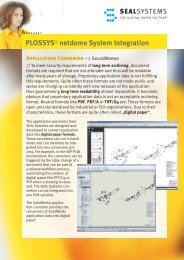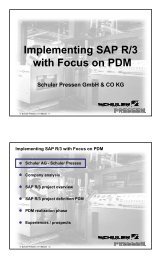You also want an ePaper? Increase the reach of your titles
YUMPU automatically turns print PDFs into web optimized ePapers that Google loves.
� Extensions<br />
Demand-oriented scanning<br />
(„Scan-on-demand“)<br />
By means of the specific dialog processes of the<br />
<strong>PLOSSYS@rchive</strong> documents can be ordered the master<br />
record of which has not been stored in the archive yet. It is<br />
also possible to request documents that have not been<br />
scanned yet.<br />
The PLOSSYSTM repro list processing allows together with the<br />
Scan List Client to build up very effective acquisition<br />
processes.<br />
Also with partly filled archives a safe and user-friendly<br />
operation is possible.<br />
Workflow<br />
This extension allows the implementation of defined operating<br />
sequences:<br />
� release � updating service<br />
� quality assurance � four-eyes process<br />
Distribution services<br />
Distributors are lists of receivers and related print/repro<br />
parameters.<br />
Archive distributor: the distribution information is assigned to<br />
an object in the archive (changeable).<br />
Standard distributor: centrally stored and maintained<br />
distributors which are assigned to the object with printing.<br />
Personal distributors: locally stored and maintained<br />
distributors which are assigned to the object with printing.<br />
Temporary distributors: momentarily created distributor<br />
which is assigned to the object with printing.<br />
The following distribution functions are available:<br />
� Creating, deleting, maintaining, displaying a distributor<br />
The print/repro parameters that can be set include:<br />
� distributor name � marginal lettering<br />
� printer � folding type<br />
� number of copies � stamp texts<br />
� number of sets � receiver name<br />
� banner page text<br />
� Interfaces<br />
Repro Archive Universal Client (RAUC)<br />
The fully graphic user interface is the standard user surface.<br />
The mask operation and control with mouse and keyboard<br />
allows fast and faultless working. A comprehensive help<br />
functionality supports the user. The user prompt meets the<br />
practical requirements and is available in several languages.<br />
The end user can configure his program surface in such a way<br />
that it meets the requirements of his tasks:<br />
� Layout of the main display and the list of found matches<br />
� Defining the layout of the drawing list (banner page) and the<br />
master data dialog<br />
� Defining plot ID names (for job tracking)<br />
� Help function<br />
� Display of version<br />
� Starting other applications<br />
With the design great importance has been attached to a<br />
simple, intuitive user prompt. The layout meets modern<br />
Microsoft and Motif standards. Actions that cannot be<br />
activated are masked out or represented in shaded form. All<br />
important operational actions can be activated both by means<br />
of the menu operation and via colored buttons (icons).<br />
Scan List Client<br />
The special application for the scan workstation: request lists<br />
can be processed in a semi-automatic way. The basic<br />
functions include:<br />
� Selecting, displaying and printing the scan list<br />
� Scan result: displaying and editing<br />
� Assigning request and scan result<br />
� Displaying, adding and archiving master data<br />
By means of demand-oriented scanning the archive becomes<br />
useful very fast.<br />
WWW interface<br />
The Internet interface for the <strong>PLOSSYS@rchive</strong>. HTML, JAVA,<br />
SSL and HTTP are the standards for our implementation.<br />
Ideal for large and spread sites with heterogeneous<br />
infrastructure and for linking external archive users such as<br />
field service, customers and suppliers.<br />
ARCLI command line interface<br />
The script interface “arcli” (archive command line interface)<br />
allows to formulate important archive functions also on shell<br />
level. For example, simple batch-oriented archiving and export<br />
processes can be defined in process environments.




